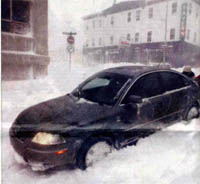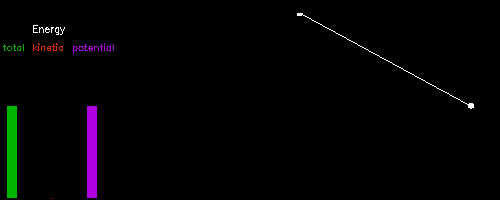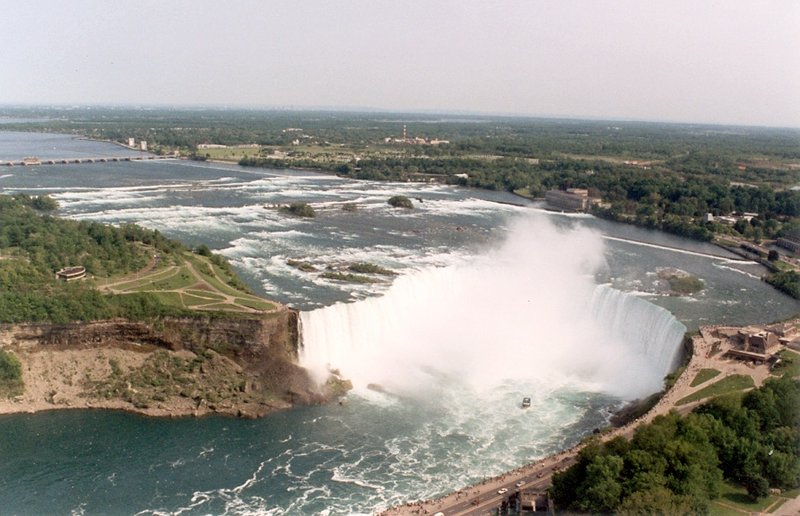Work, Energy and Power

What is Work?
In classical physics terms, you do work
on an object when you exert a force on the object causing it to move some
distance. The amount of work you actually do may have little relationship
to the amount of effort you apply.  For
example, if you push on a car stuck in a snow drift, you may exert a lot
of force (and effort) but if the car does not budge, you have not done
any work! In order for work to be done on an object, the object must move
some distance as a result of the force you apply. There are also constraints
on the force you apply. Only force exerted in the same direction as the
movement of the object result in work. You may think that you do a lot
of work if you carry an arm full of books from home to school. In reality
you do no work at all! In carrying the stack of books, you exert an upward
force to hold the books so they don't fall to the ground. There is no
movement associated with this force. As you walk, the motion of the books
is horizontal not vertical. Since the force applied to the books is vertical,
and the motion is horizontal, you do not do any work on the books.
For
example, if you push on a car stuck in a snow drift, you may exert a lot
of force (and effort) but if the car does not budge, you have not done
any work! In order for work to be done on an object, the object must move
some distance as a result of the force you apply. There are also constraints
on the force you apply. Only force exerted in the same direction as the
movement of the object result in work. You may think that you do a lot
of work if you carry an arm full of books from home to school. In reality
you do no work at all! In carrying the stack of books, you exert an upward
force to hold the books so they don't fall to the ground. There is no
movement associated with this force. As you walk, the motion of the books
is horizontal not vertical. Since the force applied to the books is vertical,
and the motion is horizontal, you do not do any work on the books.
Work is a transfer of energy so work is done on an object when you transfer energy to that object. The amount of work done on an object depends on the amount of force exerted on the object and the amount of distance the object moves.
Work = Force x Distance
According to Newton's Second Law of Motion, the net force on an object is dependent on the mass of the object, and its acceleration during the movement.
Force = Mass x Acceleration
The common unit of force is the Newton (N). One Newton is the force required to accelerate one kilogram of mass at 1 meter per second per second.
1 N = 1kg m/s2
The amount of work done to push a 10,000 N car a distance of 10 meters would be
10,000 N x 10 m = 100,000 N m or 100,000 J
The Newton-meters are termed joules (J). The joule is named after James Prescott Joule (1818-1889) who first calculated the amount of electrical work needed to produce a unit of heat. In his experiments, Joule discovered that the same amount of heat was produced by the same amount of either electrical or mechanical work ("the mechanical equivalent of heat").
Learn more about work here.
What is Energy?
On March 10, 2005 sounding like an approaching locomotive, a tornado dropped out of billowing black clouds on the New Zealand town of Greymouth. The winds hurled a truck into a lagoon, snapped power poles in half, roofs sailed through the air and buildings were destroyed (go here to see a video of this disaster).
Although wind is just moving air, it possesses energy. When the wind moves the leaf on a tree or picks up and hurls a truck, it has caused a change in the position of the object. Therefore it has done work. A measure of the ability to do work or cause change is called energy. Any time an object does work on another object, some of the energy of the working object is transferred to that object raising its energy state. Like work, the units of energy are joules.
Energy is the amount of work a physical system is capable of performing so energy can be defined as that which changes the position, physical composition or temperature of an object. There are two categories of energy, kinetic energy and potential energy. The difference between them is whether the energy is being transferred (kinetic) or stored (potential). They are interconvertible.
Kinetic energy is the energy of motion (the motion of waves, electrons, atoms, molecules) while potential energy is stored energy or energy of position that has the potential to do work (follow the kinetic and potential energy links for a more in depth discussion). The kinetic energy of an object is dependent both the mass of the object and its velocity.
K.E. = 1/2 m v2
Thus a 3,000 lb car moving at 50 mph will transfer more kinetic energy than a 2,000 lb car moving at the same rate. Energy can be stored in an object by lifting it up. The amount of potential energy would be
P.E. = mgh
where m is the mass of the object; h is the height of the object, and g is the force of gravity acting on the object.

This animation shows how energy converts between kinetic and potential energy.
Animation courtesy of: http://www.bsharp.org/physics/stuff/swings.html
View how kinetic and potential energy are interrelated using a roller coaster demonstration.

A waterfall possesses both potential and kinetic energy. The water at the top of the falls possesses potential energy. As the water flows over the edge of the falls, its energy is changed into kinetic energy.
Forms of Energy
Both potential and kinetic energy come in a variety of forms.
|
Energy
Form |
Description |
Examples |
|
Mechanical Energy |
The energy associated
with the motion or position of an object. This can occur as either
kinetic or potential energy. Read
this article on mechanical energy. |
pushing a car |
|
Chemical Energy |
Potential energy stored
in the bonds that hold the atoms together in a molecule |
fossil fuels, food
energy |
|
Thermal Energy |
The internal energy
of substances caused by vibration and movement of atoms and molecules
within the substance. |
hot water, steam |
|
Electrical Energy |
The energy of moving
electrical charges. |
batteries, lightening |
|
Radiant Energy |
Electromagnetic energy
that travels in waves which possess both electrical and magnetic
properties. Visible light, ultraviolet, infrared, radiowaves and
microwave radiation are all examples. |
sunlight |
|
Nuclear Energy |
Potential energy stored
in the nucleus of an atom. |
Nucleus of a uranium
atom |
|
Gravitational Energy |
Energy of place or
position. Water held behind a dam is an example of gravitational
potential energy. When the water is released, its energy becomes
mechanical energy. |
Hydroelectric reservoir |
The Law of Conservation of Energy
Within a system the amount of energy is constant. Energy can be neither created nor destroyed. However, It can be transferred from one form to another. Thu, when the water at the top of the waterfall plunges over the edge, potential energy is converted to kinetic energy. The energy of an air molecule moving in wind can be converted to rotational energy when moving the rotor of a windmill which then can be converted into electricity by a wind turbine generator. In almost all of these processes some energy is also converted into heat energy.
Units of Energy
Since we use energy to do many different types of work such as electrical, mechanical and thermal work, there are many different units used to measure the quantities of energy used. For example, the joule is a measure of electrical energy while the calorie or British thermal unit (BTU) is typically used for measuring thermal energy.
|
Some
Common Energy Units |
||
| joule (J) | The amount of work or energy exerted when a force of one newton causes a displacement of one meter | also the energy needed to maintain a flow of 1 ampere for 1 second at a potential of 1 volt in electrical applications |
| calorie (cal) |
The energy needed to raise the temperature of 1 gram of water by 1 oC 1 cal = 4.184 J |
the nutritional Calorie is in actuality a kilocalorie (kcal) 1 C = 1 kcal = 4.184 J |
| British Thermal Unit (BTU) |
The energy needed to raise the temperature of 1 pound of water by 1 oF 1 BTU = 1055 J |
the unit used extensively in engineering applications heating and cooling units (air conditioners) are rated in BTU units |
The following factors can be used to convert among these energy units:
1 J = 0.2388 cal
1 cal = 4.1868 J
1 BTU = 1.055 kJ = 0.252 kcal
|
Interesting
Fact |
To compare the energy that can be extracted from various fuel sources, we need to be able to equate the standard unit of measurement, the joule, to the units commonly used with various fuels such as gallons of gasoline, cubic feet of natural gas and metric tons of coal. The following table shows some of these energy equivalences.
Energy Equivalences
|
|
1 milllion (106) BTU equals approximately: 90 lbs of butuminous coal and lignite
production |
Here are some other useful energy equivalents and conversion factors that will be useful in comparing the energy content of different fuel sources:
WEC (World Energy Council) Standard Energy
Units
1 tonne of oil equivalent (toe) = 42 GJ* (net calorific value)
= 10 034 Mcal
1 tonne of coal equivalent (tce) = 29.3 GJ (net calorific value) = 7 000
Mcal
*NOTE:
GJ (gigajoule)= 109
J
Volumetric Equivalents
1 barrel = 42 US gallons = 158.9 liters = 0.1589 m3
1 cubic meter = 35.315 cubic feet = 6.2898 barrels
Representative Average Conversion Factors
1 tonne of crude oil = approx. 7.3 barrels
1 tonne of natural gas liquids = 45 GJ (net calorific value)
1 000 standard cubic metres of natural gas = 36 GJ (net calorific value)
1 tonne of uranium
(light-water reactors, open cycle) = 10, 000 – 16, 000 toe
1 tonne of peat = 0.2275 toe
1 tonne of fuelwood = 0.3215 toe
1 kWh (primary energy equivalent) = 9.36 MJ = approx. 2 236 Mcal
1 Therm of natural gas = 100,000 BTU
A handy calculator for converting between energy units can be accessed here. You can download an Excel unit converting spreadsheet or use this energy conversion table .
What is Power?
Energy is a measure of how much work can be done without any consideration of how long it takes to accomplish the work. Power is the measure of how quickly the work is done so it is a time-dependent function. Thus, two marathon runners do the same amount of work when they run the 26 miles, 385 yards or 42 kilometers. However, the runner that finishes the marathon in 2 hours 30 minutes runs twice as powerfully as the runner that finishes in 5 hours. Power is the amount of energy used per unit of time. The difference between energy and power is that power may be measured at any point in time, while energy has to be measured during a certain time period such as a second or an hour.
Power = Work/Time = (Force x Distance)/time
Units of Power
The unit of power is joules per second or J/s when work is measured in joules and time in seconds. The basic unit of power, 1 J/s is called a watt (W), named after James Watt who made important improvements to the steam engine. By definition, a watt is the consumption of one joule of energy per second.
1 W = 1 J/s
|
|
|
A crane lifts an 8,000-N beam 75 meters
to the top of a building in 30 seconds. How much power does the
crane use? (To check your answer, place your mouse over Mozilla.) |
If work is the transfer of energy, power is the rate at which energy is being transferred from one object to another or converted from one form into another. Light bulbs are rated by their wattage output. The power of a light bulb, its wattage, is the rate at which the bulb converts electrical energy into radiant light and thermal energy. A 100 W light bulb is brighter than a 60 W light bulb because it converts 100 joules of electrical energy per second while a 60 W light bulb converts 60 joules every second.
The watt is a relatively small amount of power. You produce about 1 W of power raising a glass of water to your mouth over a one second time period. Since the watt is such a small unit, power is often measured in kilowatts (KW). When describing the power of engines, the power unit used is often the horsepower. To promote his steam engines, James Watt compared the amount of work an engine could do to the common power source of the late 1700s, the horse. One horsepower (hp) was defined as the amount of work a horse does to lift a 33,000 pound weight a distance of one foot in one minute. This may seem like an odd definition, but it was based on the work a horse did hauling coal (Watt was trying to encourage the use of steam engines in coal mining).
1 hp = 33,000 foot-pounds (ft/lb)/min
A horse moving 33,000 pounds of coal a distance of one foot; one moving 330 pounds a distance of 100 feet; or another moving 33 pounds 1,000 feet in a minute are all exerting the same power.
The term horsepower implies the amount of muscle a particular engine has while energy tells how much "work" the engine performs during a given period of time.
|
Power
Units |
||
| Watt (W) | the power resulting from an energy dissipation, conversion, or storage process equivalent to one joule per second |
1 KW = 1000 W = 1000J/s The megawatt (MW) is the unit by which power generating plants are often rated 1 MW = 1,000,000 W |
| Horsepower (hp) |
a unit of power representing the power exerted by a horse in pulling 1 hp= 746 W |
Used to express power in mechanical energy expenditure. |
The kilowatt-hour (kWh) is a commercial unit
of electrical energy. It is the amount of energy that results from the
steady production or consumption of one kilowatt of power over one hour.
It is equivalent to 3.6 megajoules of energy or 3412 BTU. Although this
is not a standard measurement unit for any scientific system, it is the
unit by which electrical consumption in homes and businesses is measured. Direct suggestions, comments, and questions about this page
to Arlene Courtney
Last Modified January 9, 2020
